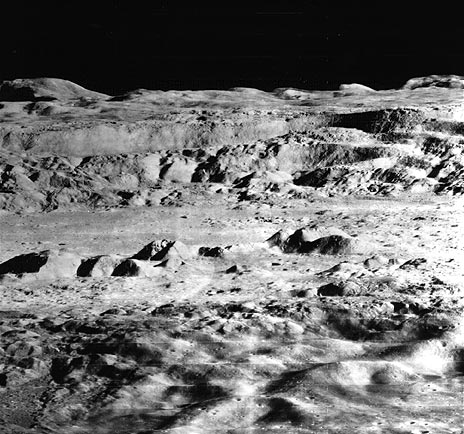Difference between revisions of "January 10, 2015"
(Created page with "__NOTOC__ == Originally published January 0, 2004 ---- ===COMMENTS?=== Register, and click on the <b>Discussion</b> tab at the top of the page. <hr> You can support LPOD when...") |
|||
| Line 1: | Line 1: | ||
__NOTOC__ | __NOTOC__ | ||
| − | == | + | =Photo of the Century= |
| − | Originally published January 0, | + | Originally published January 10, 2004 |
| + | <table width="85%" border="0" align="center" cellpadding="4" cellspacing="2"> | ||
| + | <tr> | ||
| + | </tr> | ||
| + | </table> | ||
| + | <table width="640" border="0" align="center" cellpadding="6" cellspacing="2"> | ||
| + | <tr> | ||
| + | <td> | ||
| + | <div align="center"> | ||
| + | [[File:LPOD-2004-01-10.jpeg|LPOD-2004-01-10.jpeg]] | ||
| + | <br> | ||
| + | <span class="main_sm"><b>Image Credit:</b> | ||
| + | [http://nssdc.gsfc.nasa.gov/imgcat/html/object_page/lo2_h162_3.html Lunar Orbiter II 162-H3] | ||
| + | </span> | ||
| + | </div> | ||
| + | </td> | ||
| + | </tr> | ||
| + | </table> | ||
| + | <table class="story" border="0" bgcolor="#FFFFFF" width="90%" cellpadding="10" align="center"> | ||
| + | <tr> | ||
| + | <td valign="top"> | ||
| + | <p class="story" align="center"> | ||
| + | <b>Photo of the Century</b></p> | ||
| + | <p class="story">Thirty-eight years ago, near the beginning of the Space Age, Lunar Orbiter II snapped this low oblique photo of the | ||
| + | inside of Copernicus crater, and the press labeled it the Photo of the Century. This view from above one rim, looks 93 km | ||
| + | across the crater's floor and peaks, up the terraced far wall, to profiles of the Carpathian Mountains. Clearly the sheer | ||
| + | scarp of the first terrace will be a great obstacle for future astronauts wanting to enter or leave the crater! And the | ||
| + | middle central peak seems to be breeched - its cut open from summit to floor. This looks very much like a volcanic cinder | ||
| + | cone on Earth that has had part of its wall carried away by a lava flow. But we don't see such a flow in Copernicus. What | ||
| + | we do see - or rather multi-wavelength images show - is that these peaks are olivine-rich rocks from 8-10 km depth that | ||
| + | were thrust up into the lunar sky by a rebound to the impact that excavated the crater.</p> | ||
| + | <p><b>Related Links:</b> | ||
| + | <br> | ||
| + | [http://www.lpi.usra.edu/expmoon/orbiter/orbiter-craters.html Impact Crater Geology]</p> | ||
| + | <p><b>Tomorrow's LPOD:</b> Straight Wall</p> | ||
| + | </td> | ||
| + | </tr> | ||
| + | </table> | ||
| + | <hr> | ||
| + | <p align="center" class="main_titles"><b>Author & Editor:</b><br> | ||
| + | [mailto:tychocrater@yahoo.com Charles A. Wood]</p> | ||
| + | <p align="center" class="main_titles"><b>Technical Consultant:</b><br> | ||
| + | [mailto:anthony@perseus.gr Anthony Ayiomamitis]</p> | ||
| + | <p align="center" class="main_titles"><b>A service of:</b><br> | ||
| + | [http://www.observingthesky.org/ ObservingTheSky.Org]</p> | ||
| + | <p align="center" class="main_titles"><b>Visit these other PODs:</b> <br> | ||
| + | [http://antwrp.gsfc.nasa.gov/apod/astropix.html Astronomy] | [http://www.msss.com/ Mars] | [http://epod.usra.edu/ Earth]</p> | ||
| + | <p> </p> | ||
---- | ---- | ||
===COMMENTS?=== | ===COMMENTS?=== | ||
Revision as of 20:04, 31 January 2015
Photo of the Century
Originally published January 10, 2004
|
|
|
Photo of the Century Thirty-eight years ago, near the beginning of the Space Age, Lunar Orbiter II snapped this low oblique photo of the inside of Copernicus crater, and the press labeled it the Photo of the Century. This view from above one rim, looks 93 km across the crater's floor and peaks, up the terraced far wall, to profiles of the Carpathian Mountains. Clearly the sheer scarp of the first terrace will be a great obstacle for future astronauts wanting to enter or leave the crater! And the middle central peak seems to be breeched - its cut open from summit to floor. This looks very much like a volcanic cinder cone on Earth that has had part of its wall carried away by a lava flow. But we don't see such a flow in Copernicus. What we do see - or rather multi-wavelength images show - is that these peaks are olivine-rich rocks from 8-10 km depth that were thrust up into the lunar sky by a rebound to the impact that excavated the crater. Related Links:
Tomorrow's LPOD: Straight Wall |
Author & Editor:
Charles A. Wood
Technical Consultant:
Anthony Ayiomamitis
A service of:
ObservingTheSky.Org
Visit these other PODs:
Astronomy | Mars | Earth
COMMENTS?
Register, and click on the Discussion tab at the top of the page.
You can support LPOD when you buy any book from Amazon thru LPOD!
Contributions to http://www2.lpod.org/ are licensed under a Creative Commons Attribution No-Derivative-Works Non-Commercial 3.0 License. 




